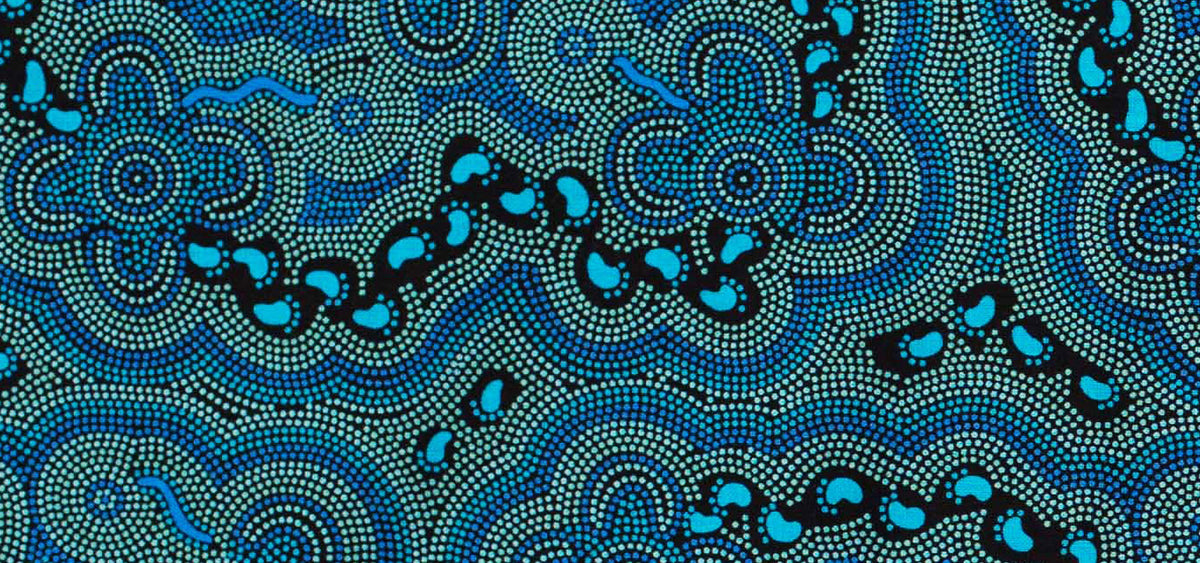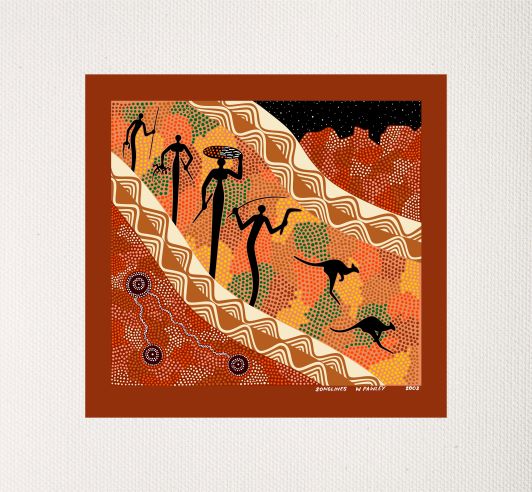Proud Member of the Aboriginal Art Association of Australia
BUSH TUCKER BLUE
By Julie Paige
We could jokingly refer to this as an Aboriginal Cook Book. We can see three people sitting at their campfire. The digging sticks and coolamons next to the seated figures confirm that they are female. They are discussing the food sources available in the area. The honey ants, small lizards, snakes and witchetty grubs are shown along with bush fruit. The womens’ footprints wander through the food probably indicating that the food may be collected.

BUSH TUCKER TAN
By Julie Paige
We could jokingly refer to this as an Aboriginal Cook Book. We can see three people sitting at their campfire. The digging sticks and coolamons next to the seated figures confirm that they are female. They are discussing the food sources available in the area. The honey ants, small lizards, snakes and witchetty grubs are shown along with bush fruit. The womens’ footprints wander through the food probably indicating that the food may be collected.


ON WALKABOUT WINE
By Karen Taylor
This painting represents when Aboriginal tribes ran out of bush tucker on their land, they would go walkabout to another area of their country where there was bush tucker. They would walk days, sometimes weeks, camping along the way which the painting shows. They would only stay in their own country, never walking onto other Aboriginal tribes land.
ON WALKABOUT OCHRE
By Karen Taylor
This painting represents when Aboriginal tribes ran out of bush tucker on their land, they would go walkabout to another area of their country where there was bush tucker. They would walk days, sometimes weeks, camping along the way which the painting shows. They would only stay in their own country, never walking onto other Aboriginal tribes land.


ON WALKABOUT BLUE
By Karen Taylor
This painting represents when Aboriginal tribes ran out of bush tucker on their land, they would go walkabout to another area of their country where there was bush tucker. They would walk days, sometimes weeks, camping along the way which the painting shows. They would only stay in their own country, never walking onto other Aboriginal tribes land.
DESERT CAMPS
By Merryn Apma Daley
In Desert Camps, Merryn uses various circles to represent where her people meet and greet each other. It is here where families will congregate, do business, live and sit on country, performing dance and ceremony.

MENS CAMP FIRE
By Merryn Apma Daley
Merryn often paints her countrymen who took care of the country for a llong time. The square symbols used throughout this artwork represent men and the countrymen sitting around the fire in the desert.


WOMEN GATHERING AT WATERHOLES
By Merryn Apma Daley
This artwork tells the story of women gathering at waterholes. As it can be extremely warm in the desert and only rains every so often, after the rain the women will gather to the sacred waterholes.
WOMENS BUSINESS
By Merryn Apma Daley
There are many meanings to this artwork by Merryn. The artwork can represent a sacred place that is only for women, where no men are allowed. It may also be used as a birthing place or where women go to simply discuss "Women's Business"


WOMEN AMONGST THE SPINIFEX ALONG THE TODD RIVER
By Merryn Apma Daley
Spinifex is a type of grass that is seen all around desert country. This grass has been used for many years by Aboriginal people for multiple purposes including medicinal, as an adhesive, and for ceremony. Women will often gather the spinifex along the Todd River.
SONGLINES
By Wendy Pawley
In the Dreamtime Biami sent the Rainbow Serpent to create the dreaming for Kamilaroi Country and along the way formed the spectacular, rugged Nandewar Ranges with the Mountains Ningadhun, Yulludunita, Kaputah, the Namoi Valley and the Kamilaroi Spirits of my ancestors.


GURAKI - THE DOLPHIN
By Wendy Pawley
In the Aboriginal Culture Dolphins are associated with the human spirit, connected through the passing down of Knowledge, Reality and Cultural Practice “The getting of Wisdom”.
BELLATA - KANGAROO
By Wendy Pawley
Bellata spirit of the Kangaroo races across the Nandewar Mountains Ningadhun, Yulludunita and Kaputah’s ridges, valleys and onto the plains of Galathera.


ALKINA MOON
By Wendy Pawley
As Alkina the Moon rose illuminating beams of light lit the night sky, birds frolicked and flew over the majestical Nandewar Mountains Ningadhun, Yulludunita and Kaputah.
KAMILAROI - MY MOTHER'S COUNTRY
By Wendy Pawley
In the Dreamtime Biami the almighty creator sent the Rainbow Serpent to create Kamilaroi Country where the spectacular rugged Nandewar Mountains Ningadhun, Yulludunita and Kaputah were formed along with the Namoi Valley. Here the Kamilaroi people camped on the banks of the Namoi River telling stories of how the “Old Spirit Man” in the sky was watching over them and if they looked out into the night sky far past the stars, they would see pulsating circles of beaming light, the eternal cyclical journey of life, death, life.


NANDEWAR HUNTING
By Wendy Pawley
The ancient Nandewar’s Mountains Ningadhun, Yulludunita, and Kaputah are situated in the vicinity of the town of Narrabri – Nurraburai Northwest NSW they also encompass the Namoi Valley where Kamilaroi people hunted and gathered food for thousands and thousands of years.

